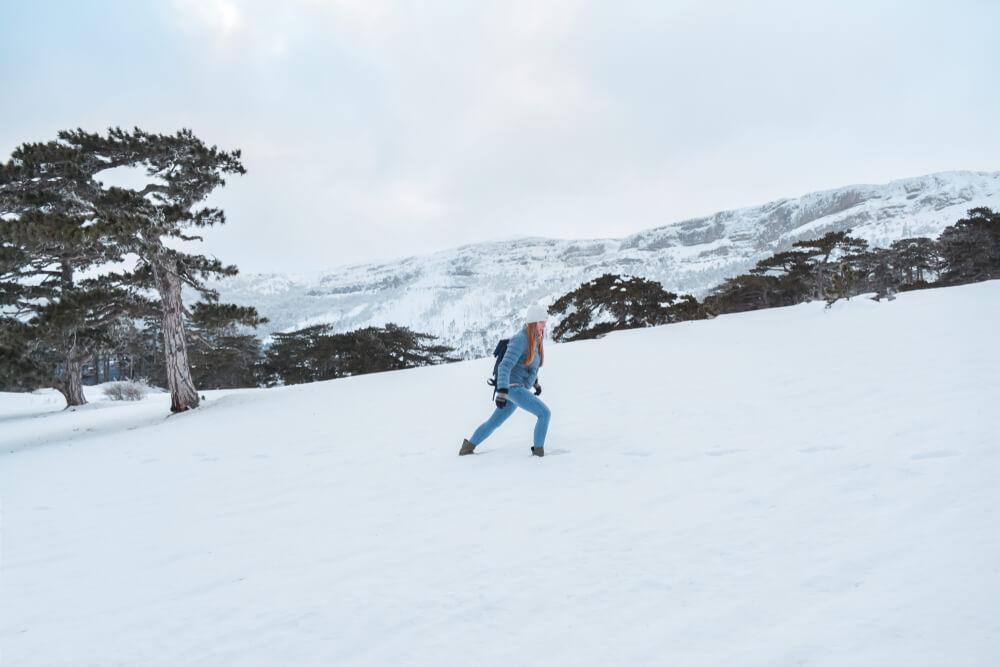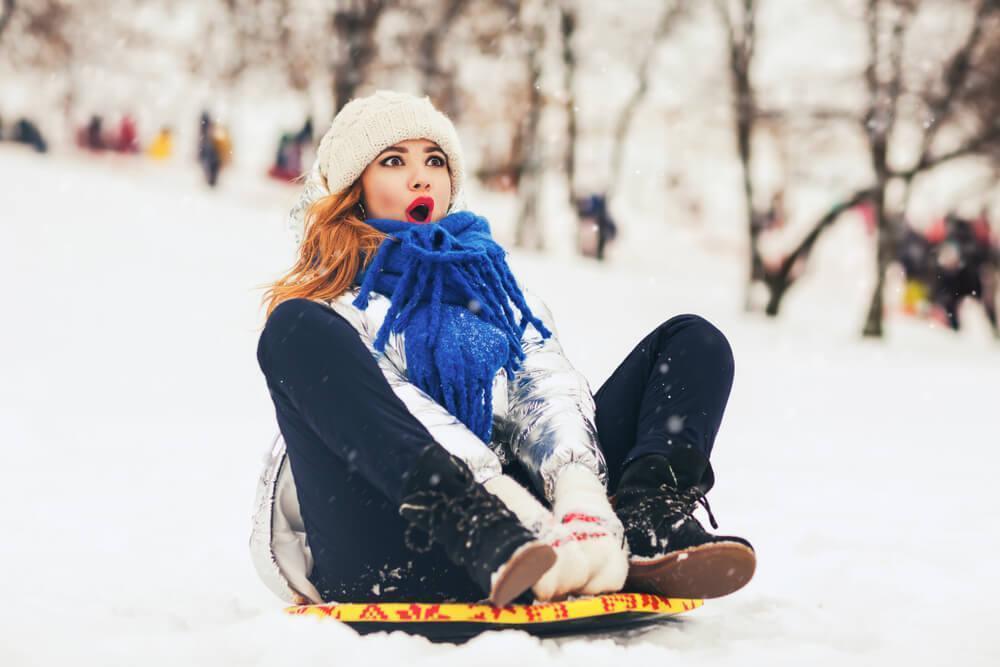
Winter is here, and that means it’s time for great food, cozy sweaters and delicious warm drinks (we’re looking at you, hot chocolate…and, well, mulled wine).
While all that sounds lovely, it all can lead quite fast to pounds piling up.
And then, when warmer weather comes, it’s really difficult to break the cycle.
But fear not, there are some great outdoor workouts that you can do perfectly well in the winter, that will certainly help you enjoy your winter without the added weight.
Benefits of Outdoor Workouts in the Winter
There are several reasons why it’s quite beneficial to work out outside in the winter. If you have adequate equipment, there’s no reason why you should be limited to indoors.
So, get ready, the great snowy outdoors are waiting for you!

But why, exactly, should you venture outside when it’s freezing and there’s probably nothing you would like more than to go into hibernation?
Well, here’s why:
- You’ll get the sunlight that you need – Some studies have shown that lack of light is linked to seasonal depression. And when is there a distinct lack of light? In the winter, of course! If you’re active outside and exposed to natural light, this will actually raise your spirits. However, don’t forget to put sunscreen – the fact that it’s cold doesn’t mean that the UV rays will miraculously bypass you!
- Exercising outside in the winter burns more calories – The fact that the body needs to warm itself up and perform the activities you set out to do means that you’ll get an added boost to your workout. Hey, it might not be too much, but it’s definitely something.
- You’ll build tolerance for the elements – Yeah, we know, the first time you go out, it’ll most likely be hell. But the second time? Already a bit easier. And it’ll keep getting easier and easier as your body slowly acclimates to the coldness. This means that you’ll be able to exercise for longer and, of course, that leads to more calories burned!
- Your immunity will improve – Exercising outside in the winter has the added benefit of boosting your immunity. That’s right, the more you exercise outside, the more immune to the flu you are. So, technically, you could even enjoy a nice bus ride with Sneezy without a care in the world! (But let’s not test that theory!)
- Your heart will become stronger – If you exercise regularly outside in the winter, your heart will work harder to send blood throughout your body. That means that it will gradually grow stronger, and that you’ll be able to do even more strenuous exercises in the future. This is a perfect introduction into a more demanding cardio routine you could do in the spring and summer!
- You’ll feel happier – Well, not at the beginning, of course. But after a while, your body starts increasing the level of endorphins it produces. (And that’s why you feel happier in general when you exercise.)
Even though it is quite challenging to work out in the winter, it’s not impossible. As long as you have the will, you’ll find a way.
You simply need to get out and do it, even for a little bit.
Believe us, it will certainly pay off!
1) Jogging

It is a well-known fact, and many experts will tell you – running is extremely beneficial, and probably the best outdoor workout that you can do. And, it is also true that running in the cold weather is, in fact, easier.
Basically, during the summer, heat and humidity are the two things that prevent us from really enjoying the run. When you run, your body temperature is likely to incline by 10 degrees on average. But, in the summer, that just means plain old discomfort for the runner. And no one likes being uncomfortable.
Also, you will be exhausted sooner if you run in high temperatures. Sweat will stick to your skin because of the humidity and it will be difficult to cool down. In the winter, however, runners are more comfortable precisely because their body temperature increases and they are able to run for longer in the cold.
And running longer means more calories burnt and more endorphins released.
If you’re not sold on the benefits of running in the winter, here’s a twist…
Just imagine lying down in your warm bed after a good run, with a hot chocolate in hand. Sounds enticing, don’t you think?
2) Hiking

Now, many people would not consider hiking to be a real form of exercise. It’s just walking, they’d say.
But boy, would they be wrong.
Whoever has gone on a hike knows they’re wrong.
Hiking in general is incredibly healthy for you, whether you do it in the winter or any other season.
But in the winter, there’s several added benefits. First, you’ll burn more calories than when you go on a normal hike. Again, as we’ve already said, your body spends additional energy just to keep your body warm. Also, you’ll most likely be going through snow, which adds more resistance to your movements.
And, ladies, take note – you will also build more muscle. According to a study, even though more calories were burnt exercising in the winter months, women were able to increase their muscle mass. However, that was not true for their male counterparts. Apparently, women could manage the cold better because their bodies used the stored fat to fuel the activity, so there was no need for their bodies to break down muscle for fuel.
So, good news for women, not so good news for men, as it were. Sometimes sucks having more muscles, doesn’t it?
3) Snowga

You might be wondering – what the hell is snowga?
Well, snow + yoga = snowga!
Simple, isn’t it?
But how would one go about exercising yoga in the snow?
After all, wouldn’t you just get wet and uncomfortable, which is kinda the opposite of what yoga is aspiring to do?
But the simple answer is – no, you will not be traipsing through the snow barefoot. Instead, you will actually be dressed as if you were going hiking or jogging. Layers are important – not too few that you end up cold, and not too many, that they inhibit your movement.
In general, yoga is great to boost your energy and lower your stress levels. But, doing yoga outside in the winter can also be incredibly fun and engaging. You will have to be mindful of every motion, and will have to stay focused and centered. Also, it doesn’t hurt that the scenery will encourage you to put in extra effort.
However, because your muscles can tense due to the coldness, you could suffer an injury if you’re not careful. That is why you should always be mindful of your limits. Know when to stop, and when to keep going and snowga will definitely repay you in the long run.
4) Ice Skating

Now, ice skating may not be the most challenging activity you can choose, but you’ll definitely feel the burn after, even if you skate slowly.
It is great if you want to strengthen your legs, particularly your inner thighs. A good side of ice skating is that it will not put any additional stress on your joints – they will be nice and snug in the boots.
You can, of course, add some workouts to your skating.
(If you’re not a fledgling struggling to keep on your two feet, that is.)
First, skate as fast as you can for about 10 yards, stop and touch the ice, then rush back to the starting spot to touch the ice again. You should to this for about a minute, and then skate slowly to catch your breath.
This is a good exercise for improving your stamina and getting your heart pumping.
Another great thing you can do on ice is play hockey. Not only will you get an exercise out of it, but you’ll also have great fun, playing with other people who are just as anxious as you to get outside. Try it, it’ll work wonders for your mind and body!
5) Sledding

Yeah, yeah, who would have thought that our favorite winter games could be turned into a calorie-burning activity? Well, it’s true.
You probably never even considered it as a child, but this is really a fun exercise.
Think about it: you’re sledding down, all the while resting, but then you have to get up a hill and do this all over again.
Now if that doesn’t say a workout, we don’t know what does.
Another thing you can do is to pull sleds. For instance, if you have kids or nieces/nephews, you can exercise by pulling the sleds, and make someone’s day. Basically, your legs and even upper body will have incredibly benefits just from the simple act of pulling the sleds.
6) Skiing

Just like with sledding, it’s such a fun activity that you don’t even notice that it’s making you sweat!
And there are various forms of skiing – you can go for the basic version, and rely on gravity, you can try cross-country skiing, which is also quite demanding, albeit less fun.
But basically, your entire body is engaged when skiing. Naturally, skiers need strong legs, but this type of activity also engages your core, your hips, as well as inner and outer thighs.
If you’re bored with the basic activity of skiing (even though this is highly unlikely), you can try your hand at snowboarding. It’s also fun, but it’s also a highly challenging activity. Your body will burn extra calories while you try to keep your balance and keep yourself warm.
How to Prepare for a Winter Workout

Now, before you jump outside to do your workouts, there are a few things you have to do to prepare properly.
Just like you wouldn’t jump into cold water in the hot summer, you also shouldn’t expose your body to something potentially harmful without preparation.
Here’s how to prepare:
Protect Your Extremities
When it’s really cold, blood tends to concentrate in the body’s center. That means that your head, hands and feet are quite vulnerable to the elements. Always make sure to wear gloves, a woolen hat and thick socks.
Always Wear Layers
You should first put on a layer that will help sweat evaporate quickly, and that is polypropylene. When it comes to legs, wear nylon tights under pants to insulate your legs. Then, it’s time for further insulation for your torso. Wear wool or fleece, but make sure there are openings to help regulate body temperature. Next, put on a windbreaker or a nylon jacket, to protect your body from wind and water, but not to add too much weight onto your body.
Apply Sunscreen to Exposed Parts of Body
Although it seems odd, it’s really not – you can actually get sunburned in the winter! Shocking, we know! Even though it’s cold, the UV rays still pose a danger to your skin. This danger is additionally increased by the snow, since it can reflect sunlight. And don’t forget to put on a lip balm that has an SPF factor.
Remember to Drink Water
Because it is cold, we are less likely to drink water in the winter. But, that doesn’t mean our bodies don’t need it, especially if we’re outside, exercising. Your best bet to avoid dehydration is to drink water before, during and after exercising. Now, if you have problems remembering that, set a timer or an alarm.
Always Warm Up
Basically, much like a regular warm-up, a warm-up in the winter also has the goal of preventing injury and enhancing performance. A good warm-up will increase the temperature of your muscles and connective tissue, making them more supple and elastic. Remember, cold and tight muscles are more prone to injury, and don’t really perform as well. So, if you want to improve your results and prevent injury, you’ll warm up properly.






Leave A Comment